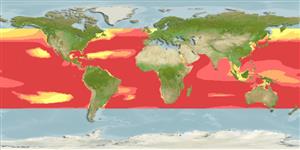>
Myctophiformes (Lanternfishes) >
Myctophidae (Lanternfishes) > Notolychninae
Etymology: Notolychnus: Greek, noton = back + Greek, lychnos, -ou = torch (Ref. 45335).
Eponymy: Both these species are named after the research vessel ‘Valdivia’ and the Valdivia expedition (1898–1899), Germany’s first expedition to explore deep seas. The holotypes were collected during the expedition. (Ref. 128868), visit book page.
Environment: milieu / climate zone / depth range / distribution range
Ecologia
marinhas batipelágico; oceanódromo (Ref. 51243); intervalo de profundidade 25 - 700 m (Ref. 4066). Deep-water; 56°N - 40°S, 180°W - 180°E
Worldwide distribution in tropical, subtropical and temperate waters. Eastern Atlantic: west of British Isles and Bay of Biscay to South Africa. Western Atlantic: Canada to Argentina. Western Pacific: between 0° and 32°S. Eastern Pacific: between 32°N and 30°S, but with 20°S southern limit in Peruvian Transitional Zone. Eastern Indian Ocean: between 9°-32°S.
Comprimento de primeira maturação / Tamanho / Peso / Idade
Maturity: Lm 1.7 range ? - ? cm
Max length : 6.3 cm TL macho/indeterminado; (Ref. 26340)
Espinhos dorsais (total) : 0; Raios dorsais (total) : 10 - 12; Espinhos anais: 0; Raios anais : 12 - 15; Vértebras: 27 - 31. Branchiostegal rays: 9 (Ref. 31422). Anal organs 8; a single deeply set translucent supracaudal gland present in both sexes, but no infracaudal gland; males have much larger eyes and a longer supracaudal gland than those of females (Ref. 39633).
High-oceanic, epipelagic and mesopelagic (Ref. 4479). Found between 375-700 m during the day and between 25-350 m at night (Ref. 4066). Size stratification with depth during the day only (Ref. 4775). Juveniles migratory; adults migratory, partially migratory or non-migratory (Ref. 4775). Feed on copepods, conchoecid ostracods and euphausiids (Ref. 4775). Oviparous, with planktonic eggs and larvae (Ref. 31442). Also Ref. 58302.
Hulley, P.A., 1990. Myctophidae. p. 398-467. In J.C. Quero, J.C. Hureau, C. Karrer, A. Post and L. Saldanha (eds.) Check-list of the fishes of the eastern tropical Atlantic (CLOFETA). JNICT, Lisbon; SEI; Paris; and UNESCO, Paris. Vol. 1. (Ref. 4479)
Status na Lista Vermelha da UICN (Ref. 130435: Version 2024-1)
Ameaça para os humanos
Harmless
Uso pelos humanos
Ferramentas
Relatórios especiais
Baixar XML
Fontes da internet
Estimates based on models
Preferred temperature (Ref.
123201): 10 - 22.8, mean 15.2 °C (based on 1055 cells).
Índice de diversidade filogenética (Ref.
82804): PD
50 = 1.0000 [Uniqueness, from 0.5 = low to 2.0 = high].
Bayesian length-weight: a=0.00389 (0.00180 - 0.00842), b=3.12 (2.94 - 3.30), in cm total length, based on all LWR estimates for this body shape (Ref.
93245).
Nível Trófico (Ref.
69278): 3.1 ±0.20 se; based on food items.
Resiliência (Ref.
120179): médio(a), tempo mínimo de duplicação da população 1,4 - 4,4 anos (tmax=1; k >0.30).
Fishing Vulnerability (Ref.
59153): Low vulnerability (10 of 100).
